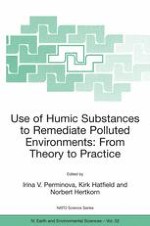
2005 | OriginalPaper | Buchkapitel
Remediation Chemistry of Humic Substances: Theory and Implications for Technology
verfasst von : I.V. Perminova, K. Hatfield
Erschienen in: Use of Humic Substances to Remediate Polluted Environments: From Theory to Practice
Verlag: Springer Netherlands
Aktivieren Sie unsere intelligente Suche, um passende Fachinhalte oder Patente zu finden.
Wählen Sie Textabschnitte aus um mit Künstlicher Intelligenz passenden Patente zu finden. powered by
Markieren Sie Textabschnitte, um KI-gestützt weitere passende Inhalte zu finden. powered by
An overview is given of the interactions encountered between humic substances (HS), ecotoxicants, and living organisms in the context of environmental remediation. The most important interactions identified include: binding interactions affecting chemical speciation and bioavailability of contaminants; interfacial interactions altering physical speciation or interphase partitioning of ecotoxicants; abiotic-biotic redox interactions that influence metabolic pathways coupled to pollutants; and finally direct and indirect interactions coupled to various physiological functions of living organisms. Because humics are polyfunctional, they can operate as binding agents and detoxicants, sorbents and flushing agents, redox mediators of abiotic and biotic reactions, nutrient carriers, bioadaptogens, and growth-stimulators. It is shown that these functions possess significant utility in the remediation of contaminated environments and as such humic-based reactions pertinent to permeable reactive barriers,
in situ
flushing, bioremediation, and phytoremediation are examined in detail. Finally, this chapter introduces the novel concept of “designer humics” which are a special class of customized humics of the reduced structural heterogeneity and of the controlled size. They are developed and deployed to carry out one or more of the above
in situ
functions in an optimum manner and for the purpose of enhancing the efficacy of one or more remediation technologies. Designer humics possess specified reactive properties obtained by chemical modification and cross-linking of the humic backbone. This new class of reactive agents portend new opportunities for achieving enhanced remediation and for quantifying remediation performance. The latter is described in the context of the passive flux meter technology developed for direct measuring fluxes of contaminants and biomass.